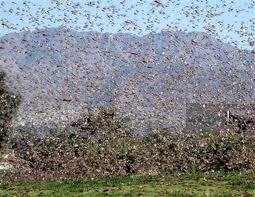
Welcome
David Burns is an environmental chemist with expertise in laboratory data audits, green chemistry, and industrial ecology. David is available to help business & professionals integrate sustainable supply chains and energy efficiency into service offerings. The following blog topics are intended to invoke awareness and/ or action in Going-Green. You are also invited to create a Free Whoisgreen business profile using the link above. David Burns is a NSC member of the Rocky Mountain Institute.

Will the NSW DPI (Agriculture) and the APVMA control permits be enough to prevent toxic insecticides from entering food supplies that may end up for sale on supermarket shelves?
Aerial spraying of toxic insecticidal chemicals provided by companies such as NuFarm have always been viewed by the general public with skepticism and application of caution. The current Nyngan Locust Plague story being portrayed on our loungeroom TV news feeds depicts potential risks and losses in agricultural terms, however very little is being mentioned about the toxicology of the chemicals themselves, nor anything about the agri-companies supplying the chemicals and the information known about cross contamination into the food supply chain. The current Nyngan Locust Plague control strategies & prescribed methods being managed by the Department of Primary Industries (DPI) and the Australian Pesticide and Veterinarian Manufacturers Association (APVMA) confirm the risk that chemical spraying poses. How will the public know if these two departments are maintaining an effective barrier between locus control and the environment, food chain, and farmer's livelihoods?
Information provided by the NSW DPI states that, 'Livestock that has been oversprayed or which eat insecticide treated feeds before the grazing/ fodder withholding period for a speciific insecticide has expired must not enter the milking herd, or be slaughtered for human consumption until the Export Grazing Interval (EGI) has expired, unless they have been kept on clean pasture or feed for the duration of the EGI for the particular insecticide'. My experience in working in analytical testing laboratories has allowed me to form the opinion that farmers affected by the Nyngan Locust Plague will not typically know when crops or livestock have been unintentionally exposed to 'invisable' chemical sparaying unless they witness it, or are notified by random sample testing results. Testing is expensive and takes time, something that markets usually prefer to avoid, so I it should be expected that any control barrier will have weaknesses.
In addition, it is well known that hay, and other grains can retain chemicals and insecticides for lengthy periods of time. Acording to Simon Oliver, 'Insecticides used to control locusts must be approved by the APVMA and all landholders need to be aware of responsibilities under state control of use legislation. Growers are reminded to observe withholding periods (WHPs) for grain, hay, pastures, meat, milk or any other production following the use of insecticides to control locusts'.
For more information on chemicals and their effects during the Nyngan Locust Plague, the NSW Dept of Primary Industries Australian Plague Locust Program 2010 provides the names of chemical insecticides, agri-comapnay suppliers, and their respective Material Safety Data Sheet (MSDS).
What can the consumer do? Check what you are eating and ask your local merchant for organically certified meat, fish, eggs, chicken, and look for organic cerals where possible to avoid toxic chemicals. Support farmers that have concerted their farms to certified oganic farming practices that break the repetition of the 'treat-harvest-treat' cycle. Research in the US is focusing back to agricultural systems based on perennial crops that 'have the ecological stability of the prairie and a grain yield comparable to that from annual crops' which allow the soil condition to develop into a complex state that cannot be reach where annual chemical treatment and tilling is practiced to produce food for people and livestock feeding. American farming researcher and President of the Land Institute Wes Jackson discusses the possibility of looking to a complex prairie for answers as an analogy for modern farming practices. Watch his first YouTube video below...
Natural farming practices are the future of healthy food supply.
David Burns is a Sustainability Advisor and Analyst, www.sustain450.com.au
If you have a friend that you would like to share this with, then









